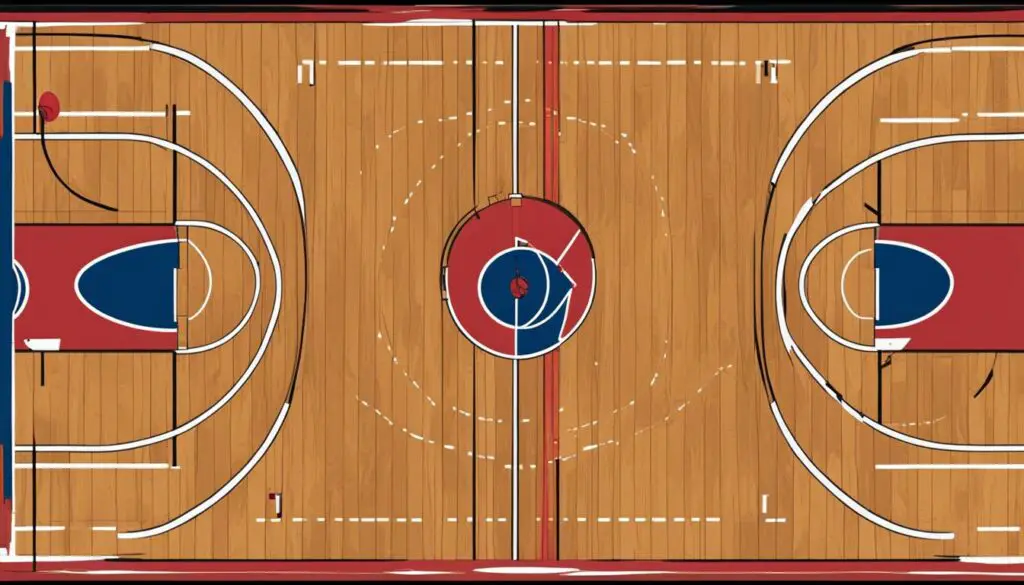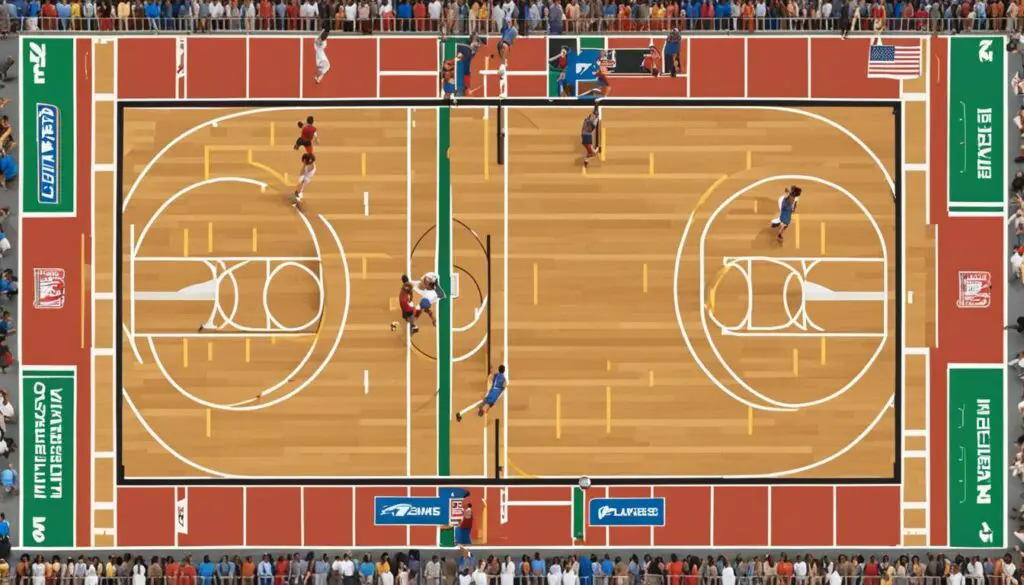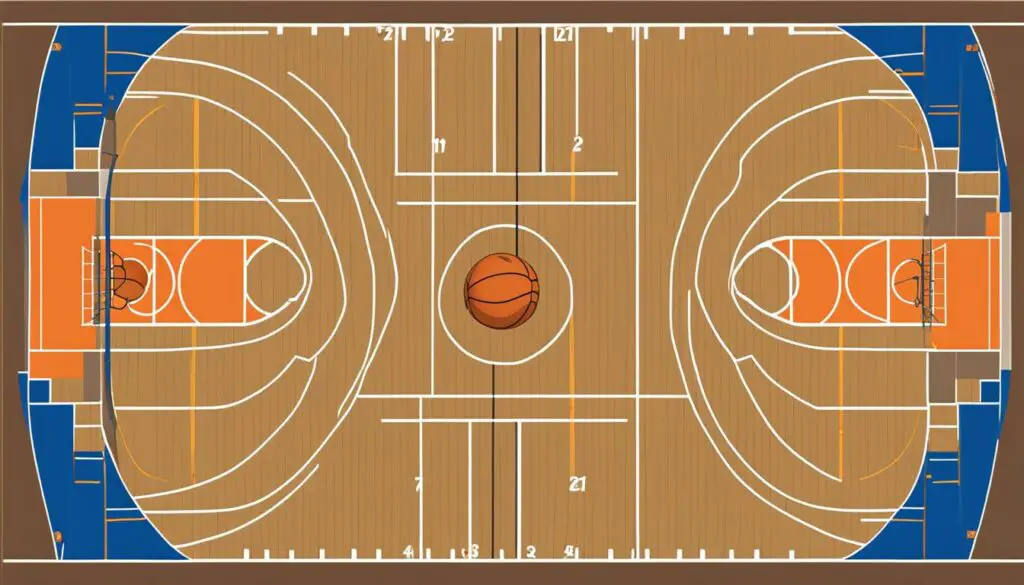Have you ever wondered why college basketball plays in halves? This article will take a closer look at the reasons behind this unique format and the rules that govern college basketball. Understanding the history and traditions of the game can help us appreciate the rhythm and excitement that halves bring to men’s college basketball.
Key Takeaways:
- The two-half format in men’s college basketball is rooted in tradition and the desire to preserve the unique characteristics of the game.
- Dr. James Naismith initially designed basketball with two 15-minute halves, and the format has stood the test of time.
- Maintaining the two-half format contributes to the distinctive rhythm and flow of men’s college basketball games.
- Switching to quarters, as in women’s college basketball, would require adjustments in foul counting and gameplay.
- The decision to play in halves enhances the competitiveness and intensity of men’s college basketball.
The Origins of Two Halves in College Basketball
Dr. James Naismith, the inventor of basketball, established the original game format with two 15-minute halves. Naismith’s intention was to keep the game simple and minimize contact between players. This early design laid the foundation for the evolution of college basketball as we know it today.
As the sport became more organized and established at the collegiate level, the two-half format persisted and became a fundamental part of men’s college basketball. The regulations governing the game embraced this format, recognizing its historical significance and the unique character it brings to the sport.
Today, the two-half structure remains a living relic of Naismith’s original vision for basketball. It is a testament to the enduring traditions and history embedded within men’s college basketball, showcasing the deep roots from which the game has grown and developed.
Transition to Quarters in Other Leagues
In 1954, the NBA made the transition to a four-quarter system, influenced by the desire for more commercial breaks, increased TV revenue, and enhanced fan engagement. However, men’s college basketball chose to retain the two-half format, preserving its unique rhythm and pace. This decision reflects an intention to honor the origins and essence of the game.
| NBA | Men’s College Basketball (NCAA) |
|---|---|
| Four quarters | Two halves |
| Increased commercial breaks and TV revenue | Preserving the game’s rhythm and pace |
| Enhanced fan engagement | Honoring the origins and essence of the game |
While the NBA saw benefits in switching to quarters, men’s college basketball recognized the value in maintaining the two-half format. This decision allows the game to retain its unique rhythm and pace, providing an experience that is distinct from other basketball leagues.
Maintaining a Unique Rhythm in Men’s College Basketball
The two-half format in men’s college basketball contributes to the distinctive rhythm and flow of the game. By dividing play into halves, college basketball offers a unique experience for fans and players. The pace and timing of the game create a higher-energy and more dramatic experience during the NCAA tournament, making it more endearing to fans.
In men’s college basketball, each half is typically 20 minutes long, resulting in a total game time of 40 minutes. This time period allows for intense gameplay and strategic decision-making within each half, keeping both teams and spectators engaged throughout the game.

Furthermore, the two-half format presents interesting challenges and opportunities for teams to adjust their gameplay strategies at halftime. Coaches analyze the first half and make necessary adjustments to tactics, gameplan, and player rotations, all aiming to gain an advantage over the opposition.
Notably, the unique rhythm of men’s college basketball extends beyond regular-season games. The NCAA tournament, known as March Madness, captures the attention and excitement of millions of fans worldwide. It is a month-long extravaganza filled with dramatic comebacks, buzzer-beating shots, and Cinderella stories. The two-half format intensifies the stakes during the tournament, as teams battle for survival and a chance to advance to the next round.
The two-half format also impacts the psychological aspect of the game. The shorter time periods in each half increase the urgency for teams, leading to more aggressive, high-scoring situations, and an exhilarating atmosphere for both players and fans.
All in all, the two-half format in men’s college basketball creates a unique rhythm and tempo that distinguishes the sport from other basketball leagues and adds to its charm. The consistent use of this format over the years has built a strong tradition and connection to the game’s origins, making it an integral part of the college basketball experience.
Differences in Foul Counting and Gameplay
The two-half format in men’s college basketball not only impacts the timing of the game but also has implications for the counting of fouls. Currently, teams in men’s college basketball reach the one-and-one bonus on the seventh foul of each half, and the two-shot bonus on the 10th foul. This system adds an element of strategy and tension to the game, as teams must be strategic about fouling and managing their foul counts.
If men’s college basketball were to transition to four quarters, the way fouls are counted and bonus free throws are awarded would need to be adjusted accordingly. In a four-quarter game, it is likely that team fouls would reset to zero at the end of each quarter, resulting in more frequent opportunities for bonus free throws.
This potential change would impact the flow and dynamics of the game, as teams would have more chances to capitalize on fouls and potentially accumulate a higher number of bonus free throws throughout a game.
Overall, the current system of foul counting and bonus free throws in men’s college basketball is intricately tied to the two-half format. Transitioning to four quarters would require significant adjustments to maintain fairness and balance in the game.
Potential Implications of Switching to Quarters
If men’s college basketball were to switch to quarters, one consequence would be a change in how team fouls are processed. In a four-quarter game, team fouls reset to zero at the end of each quarter. This adjustment could have an impact on the strategy and flow of the game, as teams would no longer have the accumulative foul count from the previous half affecting their play in the next quarter.
Additionally, the transition to quarters might result in a reduction in the number of media timeouts. Since quarters typically have fewer breaks compared to halves, the number of ad breaks and TV timeouts during the game could potentially be decreased. This could impact game pacing and viewer experience, as fans would have fewer breaks for commercial interruptions and would be able to stay more engaged with the game.
Before implementing a switch to quarters, it would be crucial to carefully consider these potential changes and their effects on the overall flow and competitive nature of men’s college basketball.

Pros and Cons of Switching to Quarters
| Pros | Cons |
|---|---|
|
|
Women’s Transition to Quarters
In the world of college basketball, the regulations for women’s games took a significant turn several years ago when they transitioned from two halves to four quarters. The decision to adopt the quarter format was made to enhance the flow of the game and align with the timing format used in other leagues such as the WNBA and FIBA. As a result, women’s college basketball games are now divided into four quarters of 10 minutes each, with a 15-minute halftime break in the middle.
This transition brought women’s college basketball closer in line with the rest of the basketball community and created a more standardized approach to game duration. By adopting the quarter format, women’s college basketball allows for a more balanced allocation of time, ensuring a fair and consistent playing experience for both teams.
The Competitive Nature of Halves
One theory behind maintaining halves in men’s college basketball is that it contributes to a more competitive game. The steady pace and flow created by the two-half format lead to more scoring opportunities and closer game-ending scores. Halves allow for less stoppage time, resulting in a more intense and engaging experience for both teams and fans.

| Game Duration | Result |
|---|---|
| Two 20-minute halves | More scoring opportunities |
| Less stoppage time | Closer game-ending scores |
| Intense and engaging experience | Enhanced competition |
Impact of Quarters on Women’s Basketball
The transition from halves to quarters in women’s college basketball has had significant implications for the game format and flow. While the switch maintains the overall essence of the sport, it introduces a new dynamic that enhances the flow and excitement of women’s basketball.
The average number of fouls and free throws per game has not seen a significant change with the adoption of the four-quarter format. This means that players and teams continue to compete under similar foul rules and scoring opportunities, ensuring a fair and balanced gameplay experience.
In terms of game length, the transition to quarters did not lead to a noticeable difference. Women’s college basketball games still provide fans with an exciting and engaging experience within a reasonable time frame.
Overall, the shift from halves to quarters in women’s basketball has been successful in maintaining the integrity of the game while adding a refreshing element to the format. The four-quarter structure has contributed to the flow and excitement of women’s basketball, further establishing its unique identity within the sport.

Men’s College Basketball Retains Its Charm
Men’s college basketball has long been characterized by the unique format of two halves, and this tradition continues to hold strong. The decision to maintain the two-half format stems from a desire to preserve the special qualities that make the game so beloved by fans and players alike.
The use of halves in men’s college basketball creates a distinct rhythm and pace that sets it apart from other variations of the game. The ebb and flow of the game, the strategic decisions made at halftime, and the thrill of a comeback in the second half all contribute to the enduring appeal and excitement of the sport.
This image captures the essence of men’s college basketball with its fast-paced action and intense competition.
The two-half format not only adds to the charm of the game but also allows for a more compact and dynamic experience. With each half lasting 20 minutes, fans are treated to a concentrated display of skill, athleticism, and teamwork. The shorter duration of halves enhances the intensity and makes every possession count.
Furthermore, the two-half format has become deeply ingrained in the history and culture of men’s college basketball. It is a part of the fabric of the sport, representing the evolution of the game over the years and honoring its roots in Dr. James Naismith’s original vision.
As college basketball continues to evolve, with new rules and innovations being introduced, the two-half format remains a constant that connects the past, present, and future of the sport. It is a reminder of the rich history and traditions that make men’s college basketball such a treasured institution.
Conclusion
In conclusion, the format of play in college basketball, with two halves for men’s games and four quarters for women’s games, is a result of historical development and intentional decisions. The two-half format in men’s college basketball honors the game’s origins and maintains a unique rhythm and pace that is beloved by fans and players alike.
Although the transition to quarters has been successful in women’s basketball, the two-half format continues to be a defining characteristic of men’s college basketball. Its steady pace and flow contribute to a more competitive game, offering fewer stoppages and more scoring opportunities. This unique experience has captivated fans for over a century.
While the game of basketball has evolved and adapted over time, the two-half format in men’s college basketball remains a cherished aspect of the sport. It not only pays tribute to the origins of the game but also creates an exciting and enduring atmosphere that sets men’s college basketball apart. It is these traditions and qualities that continue to make college basketball such a beloved and thrilling sport today.
FAQ
Why does college basketball play halves?
College basketball plays halves because it maintains a unique rhythm and pace and honors the game’s origins and traditions.
What is the history behind the two-half format in college basketball?
The two-half format in college basketball dates back to the sport’s inception by James Naismith in 1891 and has remained a beloved aspect of the game.
Has college basketball considered transitioning to quarters like other leagues?
Although other leagues, such as the NBA and women’s college basketball, have transitioned to quarters, men’s college basketball has chosen to retain the two-half format to preserve its unique characteristics.
How does the two-half format in men’s college basketball affect foul counting?
In men’s college basketball, teams reach the one-and-one bonus on the seventh foul of each half and the two-shot bonus on the 10th foul. If quarters were adopted, the foul counting and bonus free throw rules would likely need adjustments.
What would be the potential implications of switching men’s college basketball to quarters?
Switching to quarters would require adjustments in how team fouls are processed and may result in fewer media timeouts.
When did women’s college basketball transition to quarters?
Women’s college basketball transitioned to quarters several years ago to enhance the flow of the game and align with the timing format of other leagues like the WNBA and FIBA.
How has the transition to quarters affected women’s college basketball?
The transition to quarters has not significantly impacted gameplay outcomes or the length of the games, contributing to the continued flow and excitement of women’s basketball.
Why has men’s college basketball chosen to maintain the two-half format?
The two-half format in men’s college basketball honors the game’s origins, maintains a unique rhythm and pace, and contributes to a more competitive and engaging experience for players and fans.
What impact has the two-half format had on the competitiveness of men’s college basketball?
The two-half format in men’s college basketball has led to more scoring opportunities, closer game-ending scores, and a higher-energy and more dramatic experience during the NCAA tournament.
How has the transition to quarters affected women’s basketball?
The transition to quarters has not significantly affected gameplay outcomes or the flow and excitement of women’s basketball, contributing to the continued success of the sport.
Why is the two-half format in men’s college basketball still cherished?
The two-half format in men’s college basketball is cherished for its tradition and unique characteristics that make the game special, even as the sport continues to evolve.
Source Links
- https://www.jrzy.com/post/why-does-mens-college-basketball-play-two-halves-instead-of-four-quarters
- https://www.sportingnews.com/us/ncaa-basketball/news/ncaa-womens-basketball-quarters-halves/mhw1cdc5tgbsznjglsesixwo
- https://www.azcentral.com/story/opinion/op-ed/claythompson/2017/02/04/ask-clay-you-want-basketball-game-halves-quarters/97401660/
